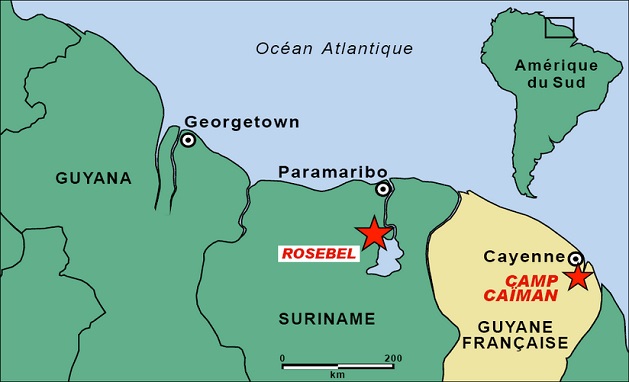Camp Caiman, French Guiana

Location

History
2008 of a moratorium on all mining and exploration activity.
2008 Guiana, challenging the improper denial of the Company’s mining permit and seeking compensation for
2008 damages in the amount of 275 million Euros. The Company records a non-cash impairment charge
2008 of $88.8 million for the net carrying value of the Project.
2008 decision. The French Government provides more detailed reasons and again denies to issue a mining
2008 permit. IAMGOLD files a second permitting appeal.
2008 claim. In May, IAMGOLD appeals the decision to the Administrative Court of Appeal in Bordeaux and
2008 increases the compensation claim to 763 million Euros to account for higher gold prices.
Source: http://www.iamgold.com/English/Operations/Development-Projects/Camp-Caiman/Overview/default.aspx

|
- Design and supervision of construction of geotechnical and hydrological structures such as foundations, slopes, excavations, diversion ditch, and dams;
- Investigation of ground instabilities and recommending and designing mitigation measures
To purchase materials, goods, and services for all operations, maintenance, and support functions.
To provide safe and cost-effective survey services, by way of design, plans, and measurement data that communicate critical mining instructions to operators and development results to engineers.
To provide administrative support and ensure the efficient and effective functioning of the mill office and related activities.
The purpose of the Mine Road Supervisor is to ensure all site service roads are maintained year round.
The purpose of the Supervisor Mine is to supervise the mine crew and ensure production targets and schedules are met as forecast.
The Senior Mining Engineer takes part in the development of economic studies of mining projects (approach, prefeasibility, feasibility).
To ensure optimization of the Mill process is maintained through effective management and technical support to the Operations group as well as external support groups including Mine Technical Services and Mine Operations.
As a member of the Global Supply Chain (GSC), the analyst will utilize your abilities to provide actionable recommendations to the leaders of the organization.
This position is responsible to manage all maintenance activities including; safety, execution, personnel, budget, planning and continuous improvement.